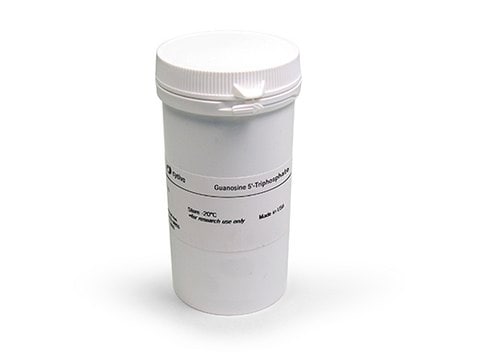10999644001
Roche
SP6/T7 Transcription Kit
sufficient for 2 x 20 assays (stadard transcription), kit of 1 (12 components), suitable for DNA sequencing, suitable for hybridization
Synonyme(s) :
rna labeling, radioactive, transcription kit sp6/t7
About This Item
Produits recommandés
Utilisation
sufficient for 2 x 20 assays (stadard transcription)
Niveau de qualité
Conditionnement
kit of 1 (12 components)
Fabricant/nom de marque
Roche
Technique(s)
DNA sequencing: suitable
hybridization: suitable
Température de stockage
−20°C
Description générale
DNA inserted into the transcription vectors pSPT18 or pSPT19.The template DNA must be linearized with a suitable restriction enzyme before the transcription reaction to obtain transcripts of a defined length. Using intact plasmid DNA as template for transcription will result in heterogeneous transcripts of multiple plasmid lengths.
Spécificité
Application
For in vitro transcription of DNA sequences cloned downstream of the SP6 or T7 promoter. Homogeneously labeled RNA can be synthesized with high efficiency (60 - 70% incorporation) using either radioactively (e.g.,32P, 3H, 35S) labeled or nonradioactively (e.g., digoxigenin or biotin) labeled ribonucleotides. Labeled transcripts lend themselves to all DNA and RNA hybridization techniques and are also used for genomic sequencing and S1 nuclease studies. Large amounts of highly pure RNA can be synthesized using the SP6/T7 system. These transcripts are used for studies on RNA-processing systems. Synthesized RNA can be translated in vitro, or in vivo after injection into oocytes. The transcription of defined mRNA can be inhibited by the introduction of "antisense"-RNA. The efficiency of in vivo translation of synthesized mRNA can be increased significantly by the introduction of a cap structure.
Conditionnement
Principe
Notes préparatoires
ATP, GTP, UTP mixture
Prepare the ATP, GTP, UTP mixture by making a 1:1:1 mixture of solution 4, solution 6, and solution 7.
Transcription Assay with digoxigenin-11-UTP
ATP, GTP, CTP mixture 1
Mix 1:1:1 of ATP (vial 4), CTP (vial 5), and GTP (vial 6).
UTP/DIG-11-UTP mixture
Mix 1:1 digoxigenin-11-UTP (6 mM) with UTP (vial 7) and add as one part to mixture 1.
"Cold" Transcription
ATP, GTP, CTP, UTP mixture
Prepare this mix by combining solutions in vials 4, 5, 6 and 7 at a ratio of 1111.
Autres remarques
Composants de kit seuls
- pSPT18 DNA 0.25 mg/ml
- pSPT19 DNA 0.25 mg/ml
- Control DNA, (pSPT18- and pSPT19-neo-DNA, cleaved with Eco RI) 0.5 mg/ml
- ATP, in Tris buffer 10 mM
- CTP, in Tris buffer 10 mM
- GTP, in Tris buffer 10 mM
- UTP, in Tris buffer 10 mM
- Transcription Buffer 10x concentrated
- DNase I, RNase free, in buffer with 50% glycerol
- RNase Inhibitor, in buffer with 50% glycerol
- SP6 RNA Polymerase, in buffer with 50% glycerol
- T7 RNA Polymerase, in buffer with 50% glycerol
Mention d'avertissement
Warning
Mentions de danger
Conseils de prudence
Classification des risques
Eye Irrit. 2 - Skin Sens. 1
Code de la classe de stockage
12 - Non Combustible Liquids
Classe de danger pour l'eau (WGK)
WGK 2
Point d'éclair (°F)
does not flash
Point d'éclair (°C)
does not flash
Certificats d'analyse (COA)
Recherchez un Certificats d'analyse (COA) en saisissant le numéro de lot du produit. Les numéros de lot figurent sur l'étiquette du produit après les mots "Lot" ou "Batch".
Déjà en possession de ce produit ?
Retrouvez la documentation relative aux produits que vous avez récemment achetés dans la Bibliothèque de documents.
Les clients ont également consulté
Notre équipe de scientifiques dispose d'une expérience dans tous les secteurs de la recherche, notamment en sciences de la vie, science des matériaux, synthèse chimique, chromatographie, analyse et dans de nombreux autres domaines..
Contacter notre Service technique






